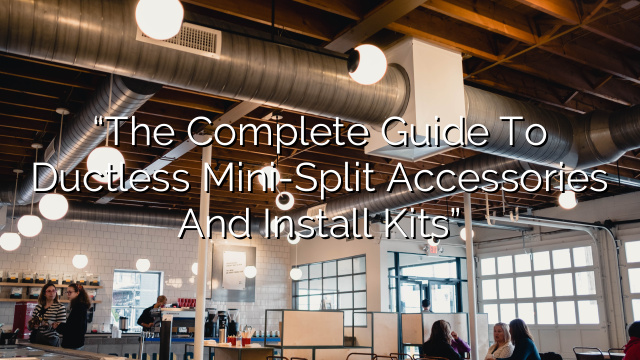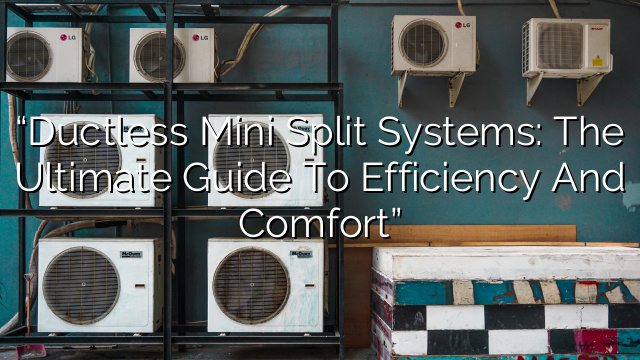Introduction
Are you considering installing a ductless mini split system in your home or office? If so, you’ve come to the right place! In this ultimate guide, we will cover everything you need to know about ductless mini split systems, including how to choose the right system and how to install it properly. Let’s get started!
What is a Ductless Mini Split System?
A ductless mini split system, also known as a mini split air conditioner, is a type of HVAC system that provides both heating and cooling to a space without the need for ductwork. It consists of two main components: an outdoor unit and one or more indoor units. The outdoor unit houses the compressor and condenser, while the indoor units distribute conditioned air into the space. These systems are highly efficient, energy-saving, and customizable, making them a popular choice for homeowners and businesses alike.
Choosing the Right Ductless Mini Split System
When choosing a ductless mini split system, there are several factors to consider:
- Cooling and Heating Capacity: Determine the square footage of the space you want to cool and heat. This will help you choose a system with the right capacity.
- Number of Zones: Decide how many indoor units you will need. Each indoor unit can cool and heat a specific zone or room.
- Energy Efficiency: Look for systems with high SEER (Seasonal Energy Efficiency Ratio) ratings for cooling and high HSPF (Heating Seasonal Performance Factor) ratings for heating. Higher ratings indicate greater energy efficiency.
- Additional Features: Consider additional features such as Wi-Fi connectivity, smart thermostats, and programmable timers for added convenience.
Installing a Ductless Mini Split System
Installing a ductless mini split system requires professional expertise, but here is a general overview of the installation process:
- Selecting the Installation Location: Choose the optimal location for the outdoor unit. It should be placed on a solid surface and away from direct sunlight and obstructions.
- Mounting the Outdoor Unit: Install the necessary brackets and mount the outdoor unit on the chosen location.
- Drilling Holes: Drill holes in the wall to connect the indoor and outdoor units. These holes should be properly sealed to prevent air leaks.
- Connecting the Refrigerant Lines: Connect the refrigerant lines between the indoor and outdoor units. This process requires precision and should be done by a professional.
- Installing the Indoor Units: Mount the indoor units in the desired locations, following the manufacturer’s instructions.
- Electrical Connections: Make the necessary electrical connections to power the system.
- Testing and Startup: Once the installation is complete, the system should be tested for proper operation and startup.
Note: These steps are a general guideline. It is important to consult a professional for proper installation and to comply with local building codes and regulations.
Ductless Mini-Split Accessories
In addition to the ductless mini split system itself, there are several accessories that can enhance its performance and convenience:
- Remote Control: A remote control allows you to easily adjust the temperature and settings of your system from anywhere in the room.
- Smart Thermostat: A smart thermostat can be connected to your ductless mini split system, allowing you to control it from your smartphone or other smart devices.
- Wired Thermostat: A wired thermostat offers a more traditional control option for your system.
- Mounting Brackets: Mounting brackets are used to securely install the indoor units on the wall or ceiling.
- Line Hide Covers: Line hide covers are used to conceal the refrigerant lines and electrical cables, providing a neat and professional look.
The Benefits of Ductless Mini Split Systems
Ductless mini split systems offer several advantages over traditional HVAC systems:
- Energy Efficiency: Ductless mini split systems are highly energy-efficient, as they don’t suffer from duct losses that can occur in central HVAC systems.
- Zonal Cooling and Heating: Each indoor unit can be controlled separately, allowing for zonal cooling and heating. This means you can adjust the temperature in different rooms or zones according to your preference.
- Easy Installation: Installing a ductless mini split system is simpler and less invasive compared to installing ductwork for a central HVAC system.
- Improved Indoor Air Quality: Ductless mini split systems feature advanced filtration systems that improve indoor air quality by removing dust, allergens, and other pollutants from the air.
- Flexible Design: The compact size and various options for indoor unit styles make ductless mini split systems a versatile choice for any space.
FAQs
Here are some frequently asked questions about ductless mini split systems:
- Are ductless mini split systems more expensive than central HVAC systems?
- Ductless mini split systems may have a higher upfront cost due to the need for multiple indoor units, but they often result in lower energy bills and reduced maintenance costs in the long run.
- Can a ductless mini split system be installed in an existing home?
- Yes, ductless mini split systems can be retrofitted into existing homes without the need for extensive renovations. The installation process is minimally invasive and does not require ductwork.
- Can a ductless mini split system be used for both cooling and heating?
- Yes, ductless mini split systems are designed to provide both cooling and heating. They can efficiently cool your space in the summer and provide warmth during the colder months.
- Are ductless mini split systems suitable for larger spaces?
- Yes, ductless mini split systems can be used in larger spaces by installing multiple indoor units. Each unit can cool and heat a specific zone, allowing for customized temperature control.
- How long do ductless mini split systems typically last?
- With proper care and maintenance, ductless mini split systems can last up to 20 years or more.
Conclusion
A ductless mini split system is a great choice for anyone looking for efficient and customizable heating and cooling. By following the steps outlined in this guide, you can choose the right system for your needs and ensure a proper installation. If you have any more questions or need assistance, don’t hesitate to reach out to a professional HVAC technician. Stay cool!












